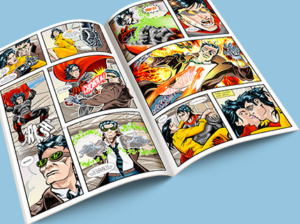Comic books, with their vibrant illustrations and dynamic storytelling, offer a unique and immersive reading experience. However, for those unfamiliar with the medium, diving into the world of comic books can be a bit overwhelming. Fear not! This guide is here to help you navigate the colorful panels and captivating narratives. Whether you’re a newcomer or a seasoned reader looking for some tips, here’s a comprehensive guide on how to read comic books.

Understanding Panel Layout When Reading Comic Books
The first step in mastering the art of reading comic books is understanding the panel layout. Comics are typically laid out in a grid of panels, each containing a moment in the story. Start by reading from the top left corner, moving across and then down, following the natural flow of the page. Pay attention to the size and shape of the panels, as they contribute to the pacing and rhythm of the story.
Absorbing Art and Text
Comic books are a marriage of art and text, and both elements play a crucial role in conveying the story. Take the time to appreciate the artwork; it’s an integral part of the storytelling process. Let your eyes wander across the page, absorbing the details in each panel. Then, read the accompanying text, which can be found in speech bubbles, captions, or sometimes integrated into the artwork itself. The synergy between words and images is what makes comics a unique form of storytelling.
Mastering Dialogue and Balloon Order
Dialogue in comic books is presented in speech bubbles, and mastering the order of these bubbles is key to understanding the conversation. Start by reading the leftmost bubble in the panel, then move to the next one, following the sequence of the conversation. Pay attention to the shape and style of the bubbles, as they often indicate the tone and volume of the character’s voice.
Consider Panel Transitions When Reading Comic Books
Panel transitions are how the story moves from one scene to the next. There are different types of transitions:
-
- Sequential Transitions: Shows a single subject progressing through a specific action.
- Aspect-to-Aspect Transitions: Explores different aspects of a scene, providing a broader view of the setting.
- Scene-to-Scene Transitions: Shifts the story from one location or time to another.
- Subject-to-Subject Transitions: Switches focus between different characters or elements within a scene.
- Non-Sequitur Transitions: Lack of a clear connection between panels, allowing for a more abstract narrative.
By understanding these transitions, you can follow the narrative flow and connect the dots between scenes, enhancing your overall reading experience.
Immersing Yourself in Pacing and Rhythm
Pacing is a crucial element in comic book storytelling. The size and arrangement of panels, along with the use of visual elements and text, contribute to the overall rhythm of the narrative. A rapid sequence of small panels can convey urgency and action, while larger, more spaced-out panels might slow down the pacing for a moment of reflection. Allow yourself to feel the ebb and flow of the story as you progress through the pages.
Exploring Story Arcs and Series When Reading Comic Books
Many comic books are part of larger story arcs or series. Understanding the concept of story arcs can enhance your reading experience, as individual issues contribute to a larger narrative. Keep an eye out for issue numbers and story arc titles, and don’t be afraid to explore different series to find characters and themes that resonate with you.
Conclusion
Reading comic books is a delightful journey that combines visual artistry with compelling storytelling. By understanding panel layout, absorbing art and text, mastering dialogue and balloon order, considering panel transitions, immersing yourself in pacing and rhythm, and exploring story arcs, you can fully appreciate the richness of this unique medium. So, grab your favorite comic book, find a cozy spot, and let the pages transport you to new and exciting worlds. Happy reading!

